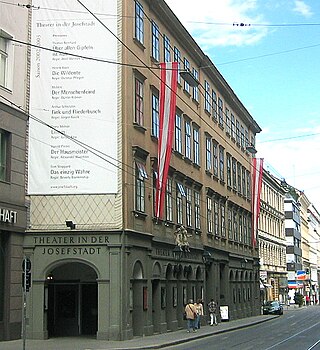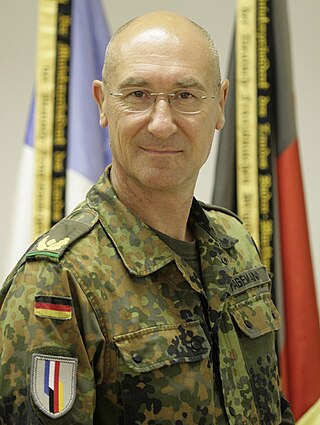
Alexander Georg von Bunge was a Russian botanist. He is best remembered for scientific expeditions into Asia and especially Siberia.

Max Johann Sigismund Schultze was a German microscopic anatomist noted for his work on cell theory.

The Theater in der Josefstadt is a theater in Vienna in the eighth district of Josefstadt. It was founded in 1788 and is the oldest still performing theater in Vienna. It is often referred to colloquially as simply Die Josefstadt.

General of the Infantry is a former rank of the German army. It is currently an appointment or position given to an OF-8 rank officer, who is responsible for particular affairs of training and equipment of the Bundeswehr infantry.
Otto Friedrich Bernhard von Linstow was a German high-ranking medical officer and helminthologist. Von Linstow was born in Itzehoe north west of Hamburg. He received his medical PhD in 1864 at the University of Kiel and worked as military doctor in Hameln, later in Göttingen, where he was promoted to a major. He published his book Compendium der Helminthology in 1878 in Hannover. Von Linstow died 3 May 1916 in Göttingen.

Microcotyle is a genus which belongs to the phylum Platyhelminthes and class Monogenea. Species of Microcotyle are ectoparasites that affect their host by attaching themselves as larvae on the gills of the fish and grow into adult stage. This larval stage is called oncomiracidium, and is characterized as free swimming and ciliated.

Opecoelidae is a family of trematodes. It is the largest digenean family with over 90 genera and nearly 900 species, almost solely found in marine and freshwater teleost fishes. It was considered by Bray et al. to belong in the superfamily Opecoeloidea Ozaki, 1925 or the Brachycladioidea Odhner, 1905.

The Diplectanidae are a family of monopisthocotylean monogeneans. They are all parasitic on the gills of fish. Diplectanids are small animals, generally around 1 mm in length. As parasites, they can be extremely numerous, up to several thousand on an individual fish.
Telorchis is a genus of trematode parasites found in many herps, comprising around 70 species. This parasite is an indirect parasite, with a snail intermediate host and a reptile or amphibian definitive host. Typically found in the gastrointestinal tract of their definitive host, telorchids attach to the wall of the intestinal tract with their ventral sucker, or acetabulum.
Microcotyle caudata is a species of monogenean, parasitic on the gills of a marine fish. It belongs to the family Microcotylidae.

Bekenntnis der Professoren an den Universitäten und Hochschulen zu Adolf Hitler und dem nationalsozialistischen Staat officially translated into English as the Vow of allegiance of the Professors of the German Universities and High-Schools to Adolf Hitler and the National Socialistic State was a document presented on 11 November 1933 at the Albert Hall in Leipzig. It had statements in German, English, Italian, and Spanish by selected German academics and included an appendix of signatories. The purge to remove academics and civil servants with Jewish ancestry began with a law being passed on 7 April 1933. This document was signed by those that remained in support of Nazi Germany.
Prosomicrocotyla is a genus of monogenean. Species of Prosomicrocotyla are ectoparasites that affect their host by attaching themselves as larvae on the gills of the fish and grow into adult stage. This larval stage is called oncomiracidium, and is characterized as free swimming and ciliated. Members of Prosomicrocotyla are characterised by a spatulate body; an haptor divided into two separate frills bordering posterior half of body proper, commencing at level of ovary; a non differentiated cirrus; a genital atrium forming a sucker-like structure armed with spines and a single middorsal vagina.

Johann Stephan Capieux was a German illustrator of Huguenot origin. He received his artistic training at the Leipzig Art Academy under Adam Friedrich Oeser. Capieux provided illustrations for










